|
LISBON FERRIES Pt.2 page |
LISBON TRANSPORT
Air Museum
Azambuja Rail Line
Carris & Ticketing
Cascais Rail Line
Coach Museum & Other Museums
Eating & Drinking
Fertagus Rail Line
Lisbon Aviation
Lisbon Bridges
Lisbon Buses
Lisbon Cablecar
Lisbon Coach Trips
Lisbon Day Trip
Lisbon Ferries
Lisbon Funiculars
Lisbon Metro
Lisbon Railways
Lisbon Railway Trips
Lisbon Ships
Lisbon Suburban
Buses
Lisbon Taxis
Lisbon Trams
Maritime Museum
Metro do Sul do Tejo
Oeiras Monorail
Sintra Rail Line
Sintra Transport
OPORTO TRANSPORT
Oporto Airport
Oporto's Bridges
Oporto Buses
Oporto (Gaia) Cable Car
Oporto Coaches
Oporto Excursions: Régua, Lamego
Oporto Funicular
Oporto Metro
Oporto Railways
Oporto Railway Trip to Coimbra
Oporto River Vessels
Oporto Tram Museum
Oporto Trams & Trolleybuses
Oporto Tram Routes Now
Oporto Transport Museum
Eating & Drinking in Oporto
ANGLO-PORTUGUESE CULTURE
Cesário Verde
Manchester/Portugal
GERMANY
Stuttgart & district
Hamburg & district
Mainz & district
Munich & district
SPAIN
Valladolid & the Cities of Castile & León
LOCAL HISTORY
Sale, Cheshire
Altrincham, Cheshire
Altrincham F.C.

Lisbon River Ferries, Part 2
Transtejo Catamarans, the SOFLUSA Ferries,
History of the Tagus Ferry Services
and River Sado Ferries
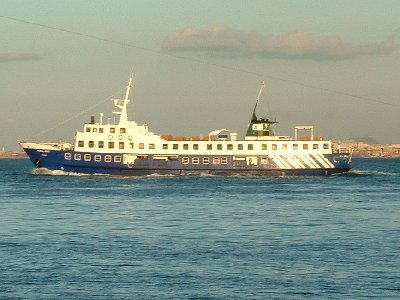
"Pinhal Novo", a SOFLUSA ferry (2003).
TRANSTEJO CATAMARANS
SOFLUSA FERRIES
HISTORY OF TAGUS FERRIES
RIVER SADO FERRIES
Copyright: ©
 15 October 2016
15 October 2016
Transtejo-SOFLUSA Catamaran Fleet
By summer 2007 Transtejo-SOFLUSA had 22 catamarans out of a total fleet of 38 vessels. As of 2016 the Transtejo e SOFLUSA fleet comprised 30 vessels which included 21 catamarans.
The names of the catamarans in 2016 were as follows... Damião de Goes, Miguel Torga, Fernando Namora, Gil Vicente, Jorge de Sena, Almeida Garrett, Fernando Pessoa, Antero de Quental, Cesário Verde, Pedro Nunes, Fantasia, Aroeira, Carnide, Sé, São Julião, Algés, Castelo, Chiado, São Jorge, Lisbonense and Almadense.
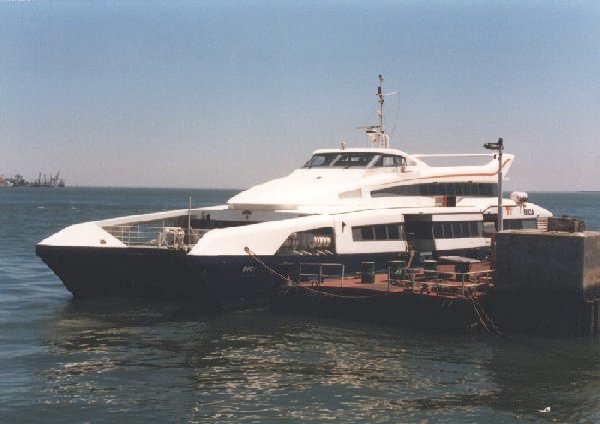
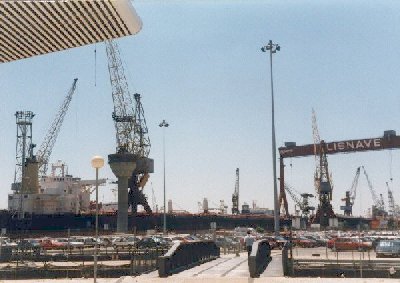
L to R: The Bica at Cacilhas; the Lisnave shipyards at Margueira/Cacilhas.
Aluminium-bodied catamarans were introduced during 1995/96.
Algés Series
Algés reg. no. LX-3168-TL. 431tons. 45m x 11.79m x 2.9m.
Powered by two Deutz diesels of 1295hp. 496 passengers and 4 crew. Service
speed of 20kt/hr, maximum of 25kt/hr. Built at Cowes, Isle of Wight, England,
by FBM Marine for 750,000 escudos. Introduced on the Montijo route on 26 September 1995.
Castelo LX-3169-TL; specification and construction as for Algés.
Chiado LX-3170-TL as above, but built under contract by Estaleiros Navais do Mondego at Figueira da Foz, Portugal.

Chiado, pictured in June 2005.
Bica LX-3171-TL, details as for Chiado, but delivered in 1996.
Aroeiro Series
This series was introduced in 1998. The catamarans were constructed by FBM Marine Ldt. on the Isle of Wight and by the Estaleiros Navais at Figueira da Foz. They carry up to 496 passengers and are 46,25 metres long (445 tons). Normal speed is 22kts (max. 30 kts).
Aroeira LX3180TL. Built in 1998 at Figueira da Foz.
Carnide LX----TL. Built at Figueira da Foz, 1998.
S. Julião LX----TL. Built at Cowes, IoW, 1997.
Sé LX----TL.
Transtejo has also acquired smaller catamarans. These are:
Parque das Nações Series
These carry 202 passengers and were built in Norway by Lindstoels Skips & B, Risoer. They carry up to 202 people and are 27,70 metres long (224 tons). Max. spped is 30knots (normal speed 22 knots).
Parque das Nações LX----TL Delivered March 2001.
Bairro Alto LX----TL (3/2001)
A one-off design is Fantasia which joined Transtejo in 2001. It was built by Brisbane Ship Constructions and carries 150 passengers. It is 26.4 meters long (78 tons). Maximum speed is 26 knots (22kts normal).
Fantasia LX----TL Built in Brisbane, 1999 and started in Lisbon in 2001 for the Parque das Nações to Cacilhas crossing.
Cesário Verde Series
These are Australian built by Image Marine, are 37 metres long and carry 292 passengers at 30 knots and enetred service in 2002. They hold 292 passengers. The catamarans are 37.4 metres long, and have a crusing speed of 22kts/hr , (max. 27kts).
Pedro Nunes LX----TL (?4/02)
Cesário Verde LX----TL (?4/02)

Damião de Goes Series
Built by Damen (Singapore), these aluminium vessels are 49.2 metres long, 713 tons and have an operating speed of 22kts (max. 30 kts). They operate the service from Terreiro do Paço to Barreiro and still carry the SOFLUSA logo (see below). Their service speed is 22km/hr but they are capable of 30km/hour.
Damião de Góes LX----TL (2003 with SOFLUSA)
Augusto Gil LX----TL
Miguel Torga LX----TL
Fernando Namora LX----TL
Gil Vicente LX----TL - pictured right in June 2009.
Jorge de Sena LX----TL
Almeida Garrett LX----TL
Fernando Pessoa LX----TL
Antero de Quental LX----TL
Surviving Transtejo Ferries in Other Guises
A number of former ferries survive in other guises. These include:
Rio Tejo II - as a floating
restaurant at Alcântara dock.
Trafaria Praia - as an Algarve cruiser.
Rio Almansor and Recordação - sold to Transado of Setúbal.
Almadense and Montijense - used as
dredger in Funchal, Madeira.
Castelo - sold to Oporto as the Vistadouro.
Monte de Caparica - renamed as Pontal
de Cacilhas and used as a pontoon at Cacilhas.
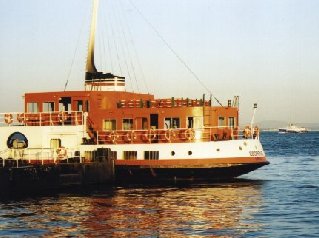
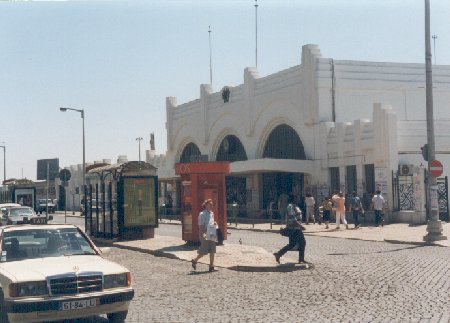
Left to right: A car-ferry, Eborense, at Cais
do Sodré (2002); the Sul e Sueste ferry terminal.
SOFLUSA Ferries
SOFLUSA for many years operated the Lisbon (Sul e Sueste) to Barreiro service to connect with railway services at Barreiro to the south of Portugal. The company is now merged with Transtejo as Transtejo-SOFLUSA and the Barreiro service is now converted to a catamaran fleet. Until 2004 SOFLUSA ran conventional ferry boats only, as listed below. Traffic is declining, which SOFLUSA ascribes to the rise in the use of cars, the closure of the Cais da Alfândega in 2001 and the work on the pontoons at Terreiro do Paço which forced the transfer of the Seixal service to the less central Cais do Sodré in 2005. The advent of the Fertagus railway service has also provided a convenient alternative route to Setúbal and other towns on the southern side of the Tagus.
The only service now operated from the new terminal (2011) at the Cais da Alfandega (near P. Comércio) is the one to Barreiro, operated by catamaran. This is still a fairly intensive seven-days a week service whose main purpose is to link to the railway services to southern Portugal at Barreiro.
Before withdrawal, the following SOFLUSA ships had capacity for 1000 passengers and were constructed between 1961 and 1970:
Alentejo
Algarve
Estremadura
Lagos
Minho
Trás-os-Montes
The following had capacity for 1600 passengers:
Pinhal Novo
Tunes
The following ships were also on charter to SOFLUSA from Transtejo:
Martim Moniz
São Jorge
The new catamarans, named after Portuguese writers, are:
Damião de Góis
Augusto Gil
Miguel Torga
Fernando Namora
They were built by Damen Shipyards of Singapore, the first being launched in January 2003. They carry 600 passengers in two saloons, with TV, ambient music, bar and toilets. They are powered by two Hamilton motors and can reach 30 knots per hour. They measure 47 metres in length.
History of Tagus Ferries
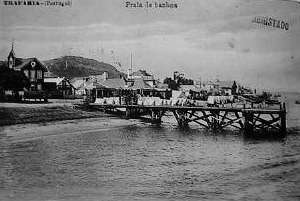 Trafaria landing stage in the early 20th century.
Trafaria landing stage in the early 20th century.
As early as January 1821 a Liverpool-built ferry, the Conde de Palmella operated a ferry service from Lisbon, north to the Ribatejo. In 1838 the first of five iron-hulled paddle-steamers were ordered from Britain; these ranged from the Tejo of 112 tons, to the 171 ton Sartórios. The other three were the D. Pedro, Infante D. Henrique and the Viriato.
These ferries were run by the Companhia do Tejo e Sado, which became the Companhia de Navegação do Tejo por Barcos Movidos por Vapor. This company also acquired the Almansor (78 tons) and the 58-ton Camões, built in Newcastle in 1853 and 1855 respectively. However the company went bankrupt in 1868. In 1860 Frederico Burnay had set up his Vapores Lisbonenses and subsequently built up a fleet serving Cacilhas, Seixal, Aldeia Galega (Montijo), Trafraia and Cascais. From 1888 this fleet was operated by Frederico Burnay Sucessores before it was absorbed into the Parceria dos Vapores Lisbonenses, (The Lisbon Steamship Partnership) in 1899.
A vehicle ferry service was started in 1903 from a terminal at Santa Apolónia, near the international railway station of the same name. This service subsequently moved to Cais do Sodré, from where passenger services also ran to Cacilhas, Seixal and Aldeia Galega, with Sunday cruises operated to Vila Franca de Xira, Algés and Trafaria. By the 1930s the Parceria ran alongside the ferries of the Caminhos de Ferro do Sul e Sueste, the railway company. This company operated to Barreiro from Terreiro do Paço and was also in cross-Tagus competition with the Damásio Vasques & Santos (DVS) company. Disaster struck on 19 December, 1938 when 29 lives were lost when a dredger and ferry collided. Also, on 9 February 1971, the Empresa de Transportes Tejo (ETT) suffered a major accident when their vessel, Rio Ave, collided with a tug and sank, though all on board were saved.
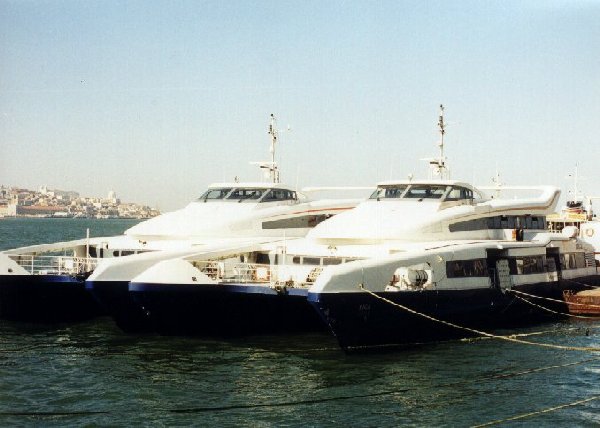
Right: The catamaran 'Bica' and a sister-vessel at Cacilhas, 2000.
By 1957 there were three main operators; Jerónimo Rodrigues Dorã (JRD), the Empresa de Transportes Tejo (ETT) and the Sociedade Nacional de Motonaves (SNM). The opening of the Ponte Salazar (now Ponte 25 de Abril), from
1966, provoked a loss of trade as did the turmoil and moves towards nationalisation after the 1974 Revolution. On 17 December 1975 five ferry companies were nationalised, (ETT, JRD, DVS, SNM and the Sociedade Marítima dos Transportes (SMT).
These became Transtejo - Transportes Tejo (TT), a public company with 26 ferries.
The CP (Railway) routes remained separately operated. Since 1994 these have been operated from Sul e Sueste to Barreiro by SOFLUSA (Sociedade Fluvial de Transportes S.A.). In 1975 TT operated services from T. do Paço to Alcochete, Cacilhas, Montijo, Seixal and Cacilhas, and from Cais do Sodré to Cacilhas, and from Belém to Trafaria and Porto Brandão, with a fleet which was now mostly old. From 1977 newly acquired vessels were introduced as was a new orange livery. In 1982 Tagus cruises began alongside the ferry services. Since 1990 the services to Seixal and Montijo have seen a growth in usage, though the new Vasco da Gama bridge and the new rail services across the Ponte 25 de Abril both threaten future growth of the ferry routes to these and other locations. The introduction of catamarans on the longer services in 1995 has helped to maintain traffic share and at least two further catamarans have been acquired in 1999/2000.
River Sado Ferries
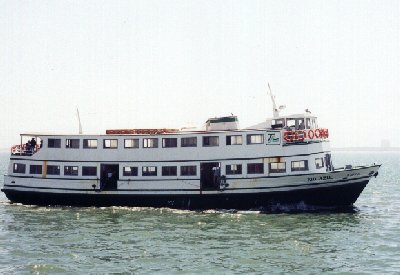
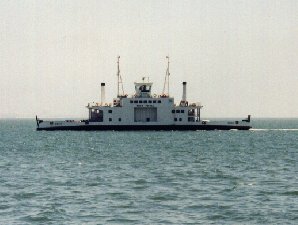 Within an hour or so of Lisbon is the city of Setúbal where more river ferries can be seen on the River Sado. Services, operated by Transado, connect the city with the Tróia peninsula, which lies about fifteen minutes away. The fleet includes both car and passenger ferries. The city may be reached by rail or by bus from Lisbon. Pictured left is the passenger-ferry, Rio Azul at the Setúbal landing-stage and, right, the car-ferry, Mira Praia, approaching Setúbal harbour.
Within an hour or so of Lisbon is the city of Setúbal where more river ferries can be seen on the River Sado. Services, operated by Transado, connect the city with the Tróia peninsula, which lies about fifteen minutes away. The fleet includes both car and passenger ferries. The city may be reached by rail or by bus from Lisbon. Pictured left is the passenger-ferry, Rio Azul at the Setúbal landing-stage and, right, the car-ferry, Mira Praia, approaching Setúbal harbour.
Curiously, the ferries now (2012) use the Viva Viagem electronic ticketing system, a used in Lisbon and even issue tickets with the ML (Metro de Lisboa) prefix. An oddity is that the ticket has to be bought at Setúbal (from machines at the ferry pontoon) for a return journey; there are no ticket facilities at Tróia as the journey from there back to Setúbal is technically free of charge! Unless you are going on to the beaches, there is little to do at Tróia though there is an excellent ice cream parlour at the end of the ferry pier!
Links
Go to Lisbon River Ferries, Part 1 for present-day Trans-Tejo
Lisbon ferry services and more pictures.
A superbly illustrated and designed web-site is Ian Boyle's Lisbon Ferries.

Reading Matter
Luís Miguel Correia, Cacilheiros. Lisboa: Edições e Iniciativas
Naúticas, 1997. 151p. bibliog. map. (ISBN 972-96940-0-1)
A superbly illustrated history of the Lisbon ferryboat, with
copious details of the modern fleet. The text is in both English and
Portuguese.
Luís Miguel Correia, Cais e navios de Lisboa. Lisbon docks and ships.. Lisboa: Edições e Iniciativas
Naúticas, 1996. 93p.
With parallel texts in English and Portuguese, this is an attractive
collection of the author's colour photographs of a wide variety of ships and boats which
have visited or inhabit the Tagus near the city of Lisbon since 1975.
Manuel Leitão, Boats of the Lisbon river: the fragata and related types..
2nd rev. ed. London: Trustees of the National Maritime Museum, 1980. 154p. bibliog.
A comprehensive guide to traditional Lisbon river boats.
Copyright: ©
Contact: the following is not a link; please transcribe the address into your email 

"Pinhal Novo", a SOFLUSA ferry (2003).
| TRANSTEJO CATAMARANS | SOFLUSA FERRIES | HISTORY OF TAGUS FERRIES | RIVER SADO FERRIES |

 15 October 2016
15 October 2016
Transtejo-SOFLUSA Catamaran Fleet
By summer 2007 Transtejo-SOFLUSA had 22 catamarans out of a total fleet of 38 vessels. As of 2016 the Transtejo e SOFLUSA fleet comprised 30 vessels which included 21 catamarans.
The names of the catamarans in 2016 were as follows... Damião de Goes, Miguel Torga, Fernando Namora, Gil Vicente, Jorge de Sena, Almeida Garrett, Fernando Pessoa, Antero de Quental, Cesário Verde, Pedro Nunes, Fantasia, Aroeira, Carnide, Sé, São Julião, Algés, Castelo, Chiado, São Jorge, Lisbonense and Almadense.


L to R: The Bica at Cacilhas; the Lisnave shipyards at Margueira/Cacilhas.
Aluminium-bodied catamarans were introduced during 1995/96.
Algés Series

Chiado, pictured in June 2005.
Aroeiro Series
This series was introduced in 1998. The catamarans were constructed by FBM Marine Ldt. on the Isle of Wight and by the Estaleiros Navais at Figueira da Foz. They carry up to 496 passengers and are 46,25 metres long (445 tons). Normal speed is 22kts (max. 30 kts).
Transtejo has also acquired smaller catamarans. These are:
Parque das Nações Series
These carry 202 passengers and were built in Norway by Lindstoels Skips & B, Risoer. They carry up to 202 people and are 27,70 metres long (224 tons). Max. spped is 30knots (normal speed 22 knots).
A one-off design is Fantasia which joined Transtejo in 2001. It was built by Brisbane Ship Constructions and carries 150 passengers. It is 26.4 meters long (78 tons). Maximum speed is 26 knots (22kts normal).
Cesário Verde Series
These are Australian built by Image Marine, are 37 metres long and carry 292 passengers at 30 knots and enetred service in 2002. They hold 292 passengers. The catamarans are 37.4 metres long, and have a crusing speed of 22kts/hr , (max. 27kts).

Damião de Goes Series
Built by Damen (Singapore), these aluminium vessels are 49.2 metres long, 713 tons and have an operating speed of 22kts (max. 30 kts). They operate the service from Terreiro do Paço to Barreiro and still carry the SOFLUSA logo (see below). Their service speed is 22km/hr but they are capable of 30km/hour.
Surviving Transtejo Ferries in Other Guises
A number of former ferries survive in other guises. These include:

Left to right: A car-ferry, Eborense, at Cais do Sodré (2002); the Sul e Sueste ferry terminal.
SOFLUSA Ferries
SOFLUSA for many years operated the Lisbon (Sul e Sueste) to Barreiro service to connect with railway services at Barreiro to the south of Portugal. The company is now merged with Transtejo as Transtejo-SOFLUSA and the Barreiro service is now converted to a catamaran fleet. Until 2004 SOFLUSA ran conventional ferry boats only, as listed below. Traffic is declining, which SOFLUSA ascribes to the rise in the use of cars, the closure of the Cais da Alfândega in 2001 and the work on the pontoons at Terreiro do Paço which forced the transfer of the Seixal service to the less central Cais do Sodré in 2005. The advent of the Fertagus railway service has also provided a convenient alternative route to Setúbal and other towns on the southern side of the Tagus.
The only service now operated from the new terminal (2011) at the Cais da Alfandega (near P. Comércio) is the one to Barreiro, operated by catamaran. This is still a fairly intensive seven-days a week service whose main purpose is to link to the railway services to southern Portugal at Barreiro.
Before withdrawal, the following SOFLUSA ships had capacity for 1000 passengers and were constructed between 1961 and 1970:
The following had capacity for 1600 passengers:
The following ships were also on charter to SOFLUSA from Transtejo:
The new catamarans, named after Portuguese writers, are:
They were built by Damen Shipyards of Singapore, the first being launched in January 2003. They carry 600 passengers in two saloons, with TV, ambient music, bar and toilets. They are powered by two Hamilton motors and can reach 30 knots per hour. They measure 47 metres in length.
History of Tagus Ferries
 Trafaria landing stage in the early 20th century.
Trafaria landing stage in the early 20th century.
As early as January 1821 a Liverpool-built ferry, the Conde de Palmella operated a ferry service from Lisbon, north to the Ribatejo. In 1838 the first of five iron-hulled paddle-steamers were ordered from Britain; these ranged from the Tejo of 112 tons, to the 171 ton Sartórios. The other three were the D. Pedro, Infante D. Henrique and the Viriato.
These ferries were run by the Companhia do Tejo e Sado, which became the Companhia de Navegação do Tejo por Barcos Movidos por Vapor. This company also acquired the Almansor (78 tons) and the 58-ton Camões, built in Newcastle in 1853 and 1855 respectively. However the company went bankrupt in 1868. In 1860 Frederico Burnay had set up his Vapores Lisbonenses and subsequently built up a fleet serving Cacilhas, Seixal, Aldeia Galega (Montijo), Trafraia and Cascais. From 1888 this fleet was operated by Frederico Burnay Sucessores before it was absorbed into the Parceria dos Vapores Lisbonenses, (The Lisbon Steamship Partnership) in 1899.
A vehicle ferry service was started in 1903 from a terminal at Santa Apolónia, near the international railway station of the same name. This service subsequently moved to Cais do Sodré, from where passenger services also ran to Cacilhas, Seixal and Aldeia Galega, with Sunday cruises operated to Vila Franca de Xira, Algés and Trafaria. By the 1930s the Parceria ran alongside the ferries of the Caminhos de Ferro do Sul e Sueste, the railway company. This company operated to Barreiro from Terreiro do Paço and was also in cross-Tagus competition with the Damásio Vasques & Santos (DVS) company. Disaster struck on 19 December, 1938 when 29 lives were lost when a dredger and ferry collided. Also, on 9 February 1971, the Empresa de Transportes Tejo (ETT) suffered a major accident when their vessel, Rio Ave, collided with a tug and sank, though all on board were saved.
The CP (Railway) routes remained separately operated. Since 1994 these have been operated from Sul e Sueste to Barreiro by SOFLUSA (Sociedade Fluvial de Transportes S.A.). In 1975 TT operated services from T. do Paço to Alcochete, Cacilhas, Montijo, Seixal and Cacilhas, and from Cais do Sodré to Cacilhas, and from Belém to Trafaria and Porto Brandão, with a fleet which was now mostly old. From 1977 newly acquired vessels were introduced as was a new orange livery. In 1982 Tagus cruises began alongside the ferry services. Since 1990 the services to Seixal and Montijo have seen a growth in usage, though the new Vasco da Gama bridge and the new rail services across the Ponte 25 de Abril both threaten future growth of the ferry routes to these and other locations. The introduction of catamarans on the longer services in 1995 has helped to maintain traffic share and at least two further catamarans have been acquired in 1999/2000.
Curiously, the ferries now (2012) use the Viva Viagem electronic ticketing system, a used in Lisbon and even issue tickets with the ML (Metro de Lisboa) prefix. An oddity is that the ticket has to be bought at Setúbal (from machines at the ferry pontoon) for a return journey; there are no ticket facilities at Tróia as the journey from there back to Setúbal is technically free of charge! Unless you are going on to the beaches, there is little to do at Tróia though there is an excellent ice cream parlour at the end of the ferry pier!
A superbly illustrated history of the Lisbon ferryboat, with
copious details of the modern fleet. The text is in both English and
Portuguese. With parallel texts in English and Portuguese, this is an attractive
collection of the author's colour photographs of a wide variety of ships and boats which
have visited or inhabit the Tagus near the city of Lisbon since 1975. A comprehensive guide to traditional Lisbon river boats.

Right: The catamaran 'Bica' and a sister-vessel at Cacilhas, 2000.
By 1957 there were three main operators; Jerónimo Rodrigues Dorã (JRD), the Empresa de Transportes Tejo (ETT) and the Sociedade Nacional de Motonaves (SNM). The opening of the Ponte Salazar (now Ponte 25 de Abril), from
1966, provoked a loss of trade as did the turmoil and moves towards nationalisation after the 1974 Revolution. On 17 December 1975 five ferry companies were nationalised, (ETT, JRD, DVS, SNM and the Sociedade Marítima dos Transportes (SMT).
These became Transtejo - Transportes Tejo (TT), a public company with 26 ferries.
River Sado Ferries

 Within an hour or so of Lisbon is the city of Setúbal where more river ferries can be seen on the River Sado. Services, operated by Transado, connect the city with the Tróia peninsula, which lies about fifteen minutes away. The fleet includes both car and passenger ferries. The city may be reached by rail or by bus from Lisbon. Pictured left is the passenger-ferry, Rio Azul at the Setúbal landing-stage and, right, the car-ferry, Mira Praia, approaching Setúbal harbour.
Within an hour or so of Lisbon is the city of Setúbal where more river ferries can be seen on the River Sado. Services, operated by Transado, connect the city with the Tróia peninsula, which lies about fifteen minutes away. The fleet includes both car and passenger ferries. The city may be reached by rail or by bus from Lisbon. Pictured left is the passenger-ferry, Rio Azul at the Setúbal landing-stage and, right, the car-ferry, Mira Praia, approaching Setúbal harbour.
Links
Go to Lisbon River Ferries, Part 1 for present-day Trans-Tejo
Lisbon ferry services and more pictures.
A superbly illustrated and designed web-site is Ian Boyle's Lisbon Ferries.

Reading Matter
Copyright: ©
Contact: the following is not a link; please transcribe the address into your email 